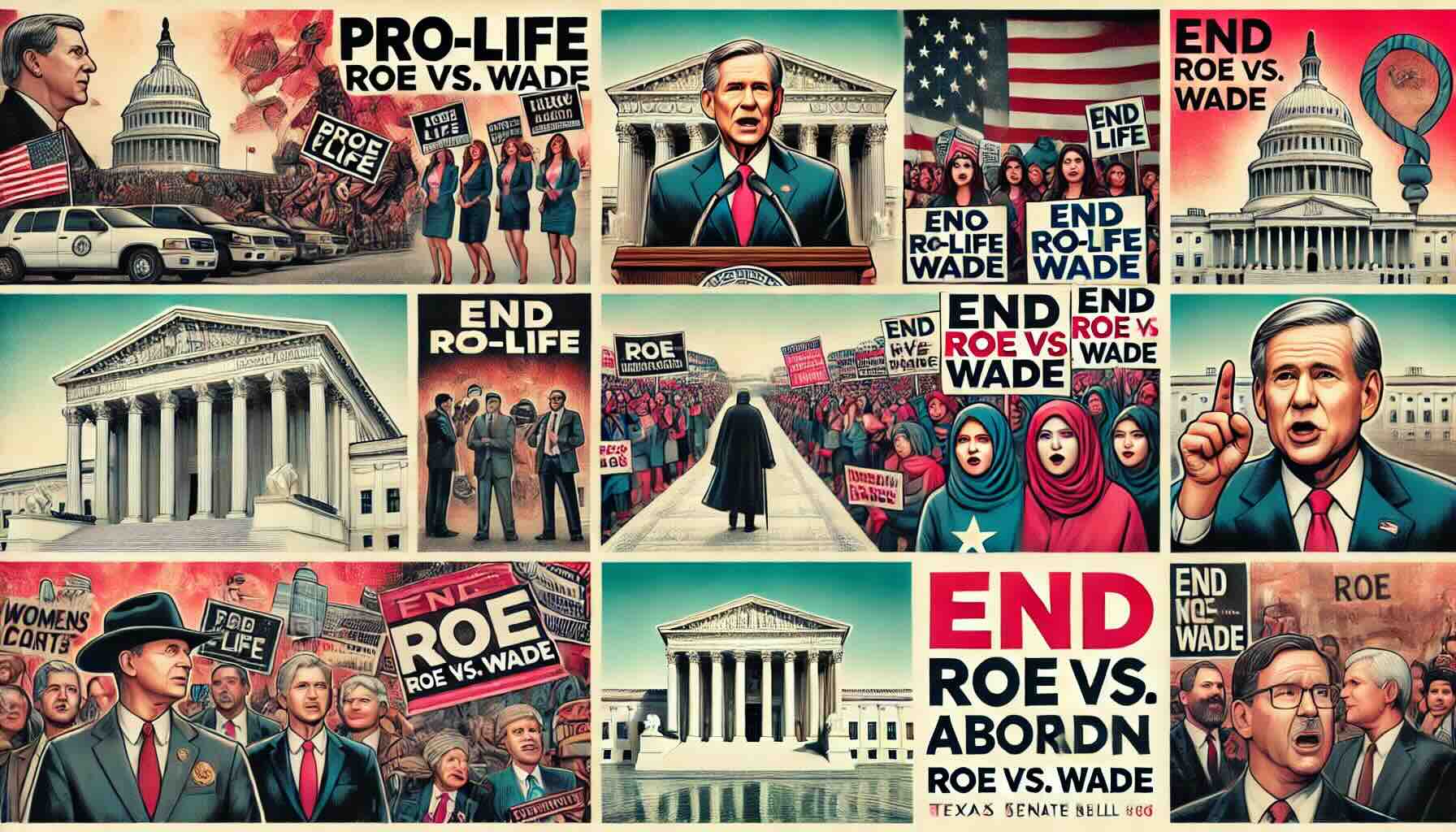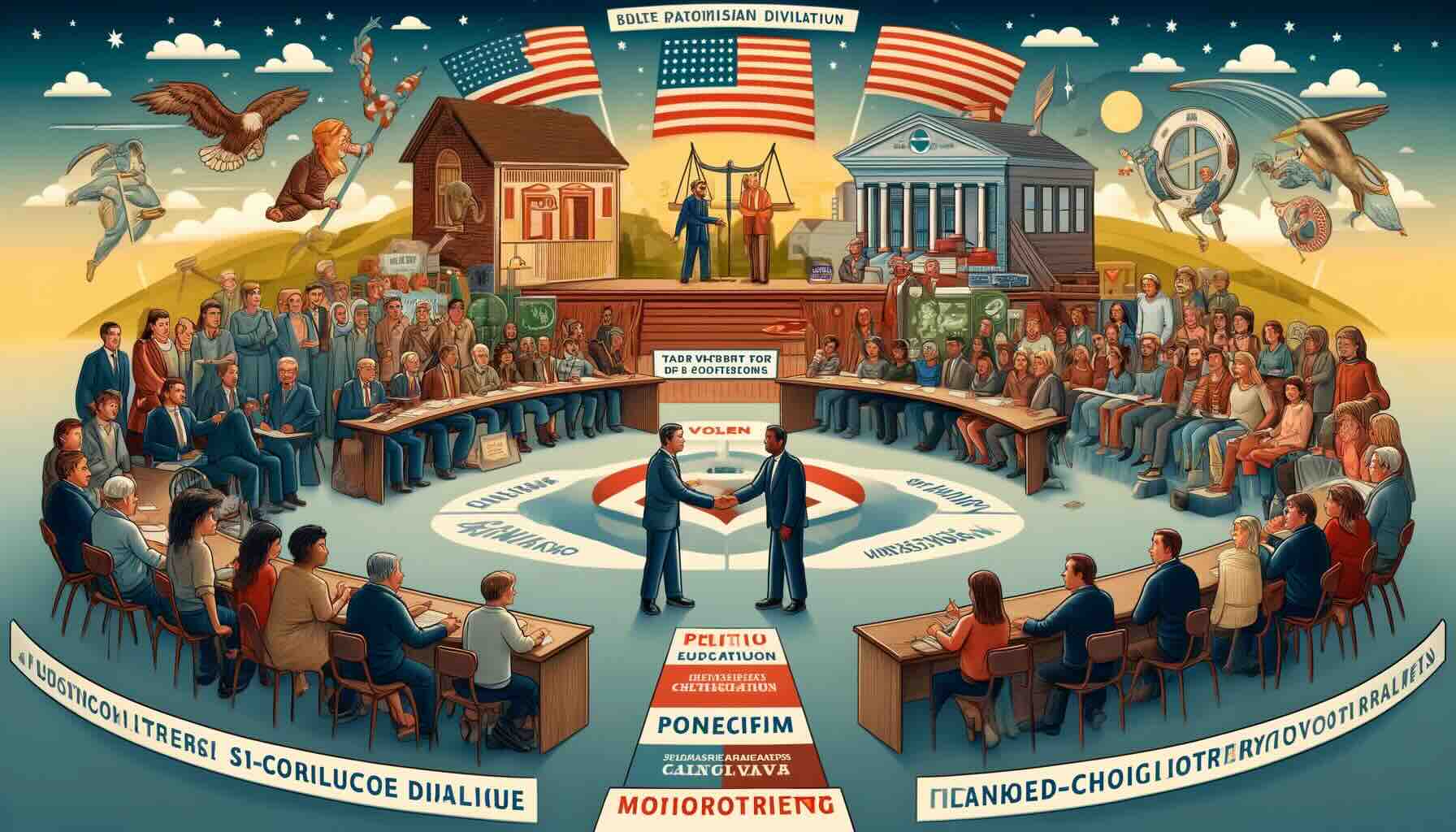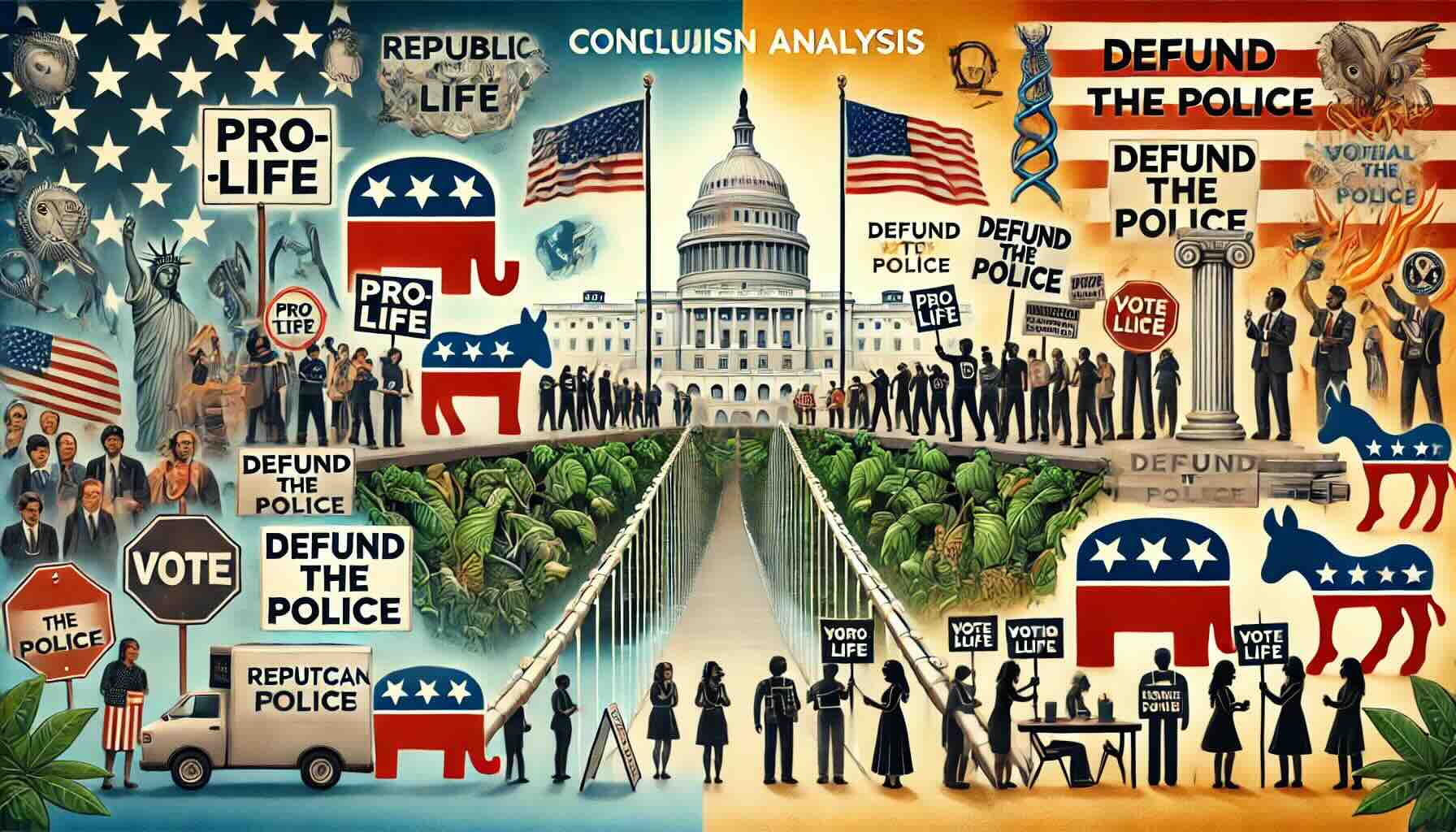Political Extremes: A Comparative Analysis of Republican and Democratic Stances on Key Issues

One might suggest that American political life has been getting more and more polarized over the last few decades. Two huge political parties—the Republicans and the Democrats, each with quite a following—have moved miles apart on a number of important contemporary themes.
Their polarization could not be reduced to the level of mere opinions; instead, each has evolved into deeply entrenched ideologies that frame policy decisions and public debate in general.
On the far end of the spectrum, political extremism is characterized by an adoption of positions or policies grossly wayward from mainstream views in the general public. Most of those extreme positions find anchorage in rigid adherence to ideological principles with little regard for consensus.
The Republican Party has had its fringe factions that push for strident positions on women's rights and abortion, in particular with the recent Supreme Court decision to abolish Roe vs. Wade.
On the extreme of the Democratic Party has been a more amplified voice for extreme views related to social justice—what many refer to as "woke mind virus"—and lax policies in cases of illegal immigration.
Elon Musk attributed his child's transition to what he termed the 'woke mind virus. ' Tesla and SpaceX CEO Elon Musk has voiced strong opposition to the use of puberty blockers in minors, sharing a personal account that has deeply influenced his stance.
The purpose of the article is, hence, to draw a fine balance in comparing these extreme positions within both parties. We intend to examine extreme Republican stances on women's rights, abortion, and the shifting perception on Roe vs. Wade with extreme Democrat approaches to social justice and immigration, seeking to understand their larger implications for American society.
This analysis will expound on the extent to which these polarized views have molded policy, public opinion, and added to political division.
Section 1: Republican Extremes on Women's Rights, Abortion, and Roe vs. Wade
Historical Context
Overview of Roe vs. Wade and its Significance
The historic Supreme Court decision in the class-action suit titled Roe vs. Wade, adjudged in 1973, set the jurisprudence for a woman's right to an abortion under the U.S. Constitution. The Court held that the woman's private right to privacy included her abortion decision, which nullified most state statutes restricting access to services that performed abortions. This decision tremendously impacted women's rights, since it placed so much more power over reproducing into women's hands and set a precedent for a number of other battles yet to be argued in court within those legal quarters.
Traditional Republican Position on Abortion and Women's Rights
Historically, the Republican Party defies abortion on moral and religious grounds and embraces a pro-life position. Republicans have historically adhered to policies guarding the rights of the child in the womb. This often put them at odds with pro-choice advocates and has been key to their party's platform for many years.
Current Extremes
Analysis of Recent Legislation and Policies Pushed by Extreme Factions Within the Republican Party
Over the last couple of years, there has also been an amping up by more extreme elements in the Republican Party of their anti-abortion measures. These include "heartbeat bills," which seek to ban pregnancies as early as six weeks, and "trigger laws," created to automatically be in effect if Roe vs. Wade is overruled. Many states have enacted such laws, further limiting access to abortionists and creating a patchwork of reproductive rights across the country.
Key Figures and Groups Advocating for Strict Anti-Abortion Measures
Politicians, such as Texas Governor Greg Abbott, and organizations like the National Right to Life Committee and Americans United for Life are on the frontline in the drive. Such individuals, combined with activist groups, have been at the forefront of initiating legislation that creates barriers to abortion access through drafting and sponsoring bills, often using their influence to shape public opinion and secure political support.
Some of These Policies' Effects on Women's Rights and Healthcare
These harsh and extreme anti-abortion measures continue to carry grave implications for the rights and health care of the women living in those states that enact these laws. Women living in states with stringent abortion laws experience insurmountable barriers to safe and legal abortion services. This leads to health complications and potential legal implications. Policies of this nature disproportionately affect low-income women and women of color who might not otherwise be able to afford the means to travel to a state with more lenient abortion policies.
Public perception and reaction
How the Public Perceives These Extreme Positions
Public perceptions over these extreme anti-abortion positions are sharply divided. Most of the Republican base may stand in support of these measures in affirmation that they protect the sanctity of life. However, many Americans outside this group actually treat these measures as draconian and an infringement on the rights of women. According to polls, a clear majority in American society states support of the right to access abortion services, thus putting up a disconnect between extreme Republican policies and broader public opinion.
Response from Women's Rights Organizations and Other Advocacy Groups
Barely feigned by great opposition are the extreme nature of these measures spearheaded from women's rights organizations, like Planned Parenthood and the Center for Reproductive Rights. Measures such as these could be viewed as threatening women's health and constitutional rights as, indeed, the women's rights organizations have decryingly articulated. Both entities have turned around restrictive abortion laws in the judiciary courts of law, quick to gain temporary injunctions impelling much greater scrutiny toward implementation.

Case studies
Specific Examples of Extreme Measures and Their Consequences
-
Texas Senate Bill 8 (SB8): This law, passed by the legislature this year, bans abortions after roughly six weeks gestation and outsources enforcement not to the government and its officials but to private individuals, who can claim a $10,000 bounty from the state if they successfully sue an abortion provider. The latter has been challenged in court as making the law virtually unchallengeable; in Texas, the decline of services was precipitous, and it encouraged copycat laws by other states.
-
Mississippi's Gestational Age Act: The law intends to make abortion illegal for almost all cases past 15 weeks of gestational age. This Supreme Court case, Dobbs v. Jackson Women's Health Organization, has the potential to overturn Roe vs. Wade, literally underscoring with those extreme measures some Republican-led states have taken to add more and more restrictions.
-
Alabama's Human Life Protection Act: A 2019 ban that holds exclusions almost up to prohibiting almost all ways of having an abortion in the state—with no exceptions for cases of rape or incest. The law has been temporarily blocked by federal courts, but it remains a stark example of the extreme anti-abortion measures being pursued by some Republican lawmakers.
All these case studies show how radical Republican policies in the domain of health and human reproduction have tangible consequences for female rights and healthcare and clearly mean that the struggle over reproductive freedom continues in the United States.
Section 2: Democratic Extremes on "Woke Mind Virus" and Illegal Immigration
Defining the Terms
Definition of the Term "Woke Mind Virus" and its Origin
The term "woke mind virus" has often been the pejorative used by critics when referring to what they believe is an overly strong emphasis on social justice, identity politics, and political correctness standing for the Democratic Party.
The word "awake" is borrowed from AAVE, where it first appeared in the sense of being aware of social and racial injustices. Over time, this was hijacked and broadened to include any heightened consciousness and activism about such social ills as race, gender, sexual orientation—the list continues. Critics argue that there is a "woke mind virus" fueling identity politics at best and intolerance to those who harbor differing views.
Democratic Position on Immigration and Related Policies Overview
On the other side, the Democratic Party mainly works on more open and humane immigration policies. These would provide pathways to citizenship for undocumented immigrants, support the Deferred Action for Childhood Arrivals program, and oppose obviously punitive or inhumane measures at their extremes, like family separations at the border. Many times, Democrats underline the role of these immigrants as contributing factors to American society and mention the need for comprehensive immigration reform.
Current Extremes
Extreme Left Policies and Rhetoric: Social Justice, Inclusivity, Immigration Analysis
Extreme democrats within the party have been touting progressive policies leaning toward social justice and inclusiveness. The bills include, but are not limited to, defunding the police, creating far-reaching anti-discrimination policies, and giving cultural sensitivity training. On immigration, far-left Democrats would abolish Immigration and Customs Enforcement, or ICE, and create sanctuary cities that scale back cooperation with federal immigration authorities.
Key Figures and Groups Promoting These Views
These progressive stances are customarily associated with such prominent figures as Congresswoman Alexandria Ocasio-Cortez and Senator Bernie Sanders. Organizations like Black Lives Matter and the Democratic Socialists of America also champion these causes.
Impact of These Policies on Society and Governance
These extreme policies being adopted have deep implications for society and governance. Meant to give a hand up to systemic inequalities, make the field more inclusive, some critics say they further polarize and socially fragment. Something like defunding the police puts serious debates on the front burner of public discourse about safety within communities and what law enforcement should look like. Sanctuary city policies have pitted local governments against the federal government at odds over immigration enforcement.
Public Perception and Reaction
How the Public Perceives These Extreme Positions
Public opinion on these radical positions is divided. One group of supporters sees the need for those policies to right deeply entrenched injustices and bring about a fair society. Another group criticizes them as extreme and idealistic, expecting them to cause a loss in social cohesion and public safety. Opinion polls reflect this division, showing marked variations depending on respondents' political affiliation and demographics.
Reaction from Conservative Groups and Critics of These Policies These extreme policies have evoked strong indignant opposition from conservative groups and many critics who say the new raft of policies amounts to ideological purity exercises, for which the party has paid with many practical solutions and turned off moderate voters. Indeed, some critics argue that a focus on identity politics and social justice can stifle free speech and create a culture of censorship. As a final point, instances of crime or disorder within sanctuary cities are frequently cited as a way that more conservative types of media can lambast lenient immigration policies.
Case Studies
Specific Examples of Extreme Measures and Their Consequences
-
Sanctuary Cities: Cities such as San Francisco and New York have enacted what are known as sanctuary policies, which make a distinction in cooperating with federal immigration authorities. Albeit arguably to protect undocumented immigrants from deportation, these policies have also caused cities legal battles and conflicts with federal agencies.
-
Debates over Language and Cultural Norms: Moves toward the so-called inclusive language and cultural sensitivity, with obligatory trainings on diversity in workplaces and schools, have only unleashed debates over free speech and where political correctness really draws the line. Critics answer that those measures can pave the way to self-censorship and a culture of obedience.
-
Defunding the Police: The defund police movement surged to the fore following the murder of George Floyd in 2020. Though some cities shifted police funds into social services, how this has affected crime rates and public safety is a topic of debate. Supporters say the systemic racism prevalent within law enforcement is being dealt with; others claim it puts public safety at risk.
-
"Woke Mind Virus": Critics point to excesses following progressive policies and rhetoric for their case against a "woke mind virus." Take, for instance, the clawback that occurred as so-called "cancel culture"—where persons or organizations are boycotted or shunned for allegedly offensive or insensitive views—has been overplayed. Or, say, the controversy over whether critical race theory should be taught in schools. Critics say the methods can breed intolerance and divisiveness; supporters argue that they help bring attention to historical and systematic injustices.
Case studies portraying the complexities and controversies of extreme Democratic policies point toward an ongoing debate as to finding a balance between social justice and pragmatic governance.
MUSK: I was tricked into giving puberty blockers to my son. These are sterilization drugs. My son Xavier is dead. They call it deadnaming for a reason. Killed by the woke mind virus. This is the reason I vowed to destroy the woke mind virus. pic.twitter.com/U4PXVyzx2Y
— Autism Capital 🧩 (@AutismCapital) July 22, 2024
Section 3: Comparative Analysis
Similarities and Differences
Comparing Methods and Rhetoric from Both Extremes
Both the extreme wings of the Republican and Democratic parties involve methods and rhetoric that are directed toward base mobilization and ideological position hardening.
Methods:
- Republicans: Far-right Republicans, at times, try to fulfill their platform by way of legislation, the judiciary, and policies at the state level. An example would be enacting restrictive abortion laws and appointing or promoting conservative-leaning judges who would uphold such laws.
- Democrats: The far-left Democrats focus on grassroots activism,/mobilization through social media campaigns, and local government policies. They push for measures, such as the defunding of police through community organizing, using social media to fan out their messages for childcare and get their support mobilized.
Rhetoric:
- Republican: The rhetoric more often than not is impregnated with muscular moral and religious overtones, reverberating with the affirmation of the inviolability of life and family values. They use terms such as "pro-life" and frame arguments on the protection of the unborn.
- Democrats: It is covered under rhetoric of social justice, equality, and inclusivity. Systemic racism, equity, and social justice are the words one reads repeatedly. A good deal of the language gives rise to an emotional appeal and a moral commitment to repair the wrongs visited on groups in history.
Analysis of the Underlying Motivations and Ideologies That Drove These Positions
- Republicans: Views on radical issues like abortion are driven by a combination of faith, adherence to their principles on the right, and protection of traditional social order. In most cases, this need to protect stems from the act of defending something primarily conceptualized as a human right or moral virtue.
- Democrats: The radicalization of these positions with respect to social justice and immigration is driven by a desire to right historical and systemic wrongs, foster inclusiveness, and safeguard the interests of the marginalized. The ideology has its roots in progressive principles that aim at reshaping society into an entity that is more just and equitable.
Impact on Political Discourse
How These Extreme Positions Come to Affect Political Discourse and Polarization. Extreme positions taken by both parties are major contributing factors to political polarization.
-
Republicans: The adoption of radical anti-abortion measures and a number of very right-wing conservative policies would push the centrists and liberals further back, enlarging the gap between left and right. It can also raise tensions and protests, which contributes to the polarization of public opinion even more.
-
Democrats: Progressive stances on social justice and immigration can similarly estrange moderate and conservative voters. Here, too, an emphasis on identity politics and inclusivity can give way to accusations of "cancel culture" and perceived intolerance of other opinions, which might further split society.
Impact on Moderate Voices from Both Parties:
- Republicans: The increasing polarization of the Republican Party tends to alienate or bind the moderate Republicans, making them vote with extreme positions, at the risk of marginalization in their own party. This could result in a more homogeneous party platform that does not represent the moderate point of view.
- Democrats: In the same way, moderate Democrats could see themselves being forced to shift towards increasingly progressive positions, fearing reprisals from their party's left wing. Again, this shifts the entire party platform to the left and erodes the effectiveness of outfits dominated by the moderates.
The extreme positions of parties on both sides further polarize an already very political scene, in which compromise is much more difficult and ideological purity tends to become, very often, prioritized above pragmatic solution making.
This is going to have an impact not only on party dynamics but also on the wider discourse on society level and lead afterwards toward a more divided and contentious political environment.
How can America unite?
Knowing where the middle ground will be in America's polarized political landscape is going to take equally broad strategies laying down a base of dialogue, understanding, and compromise.

Here are some approaches which will consolidate extreme parties and voters:
1. Encouraging Bipartisan Dialogue
- Town halls and public forums: Putting up regular town halls and public forums can really help shed light on the issues leveled against each other, whereby people from either side get together and just talk regarding the issues respectfully.
- Facilitated Discussions: Trained facilitators can help guide the discussions systematically and ensure that they remain constructive and solution-oriented.
2. Promoting Civic Education
- Civic Education Programs: Implementing civic education programs that emphasize the importance of understanding diverse perspectives and the role of compromise in a functioning democracy.
- Medialiteracy: Education in media literacy lets people critically estimate the information and, therefore, decrease the effect of misinformation.
3. Supports Moderate Candidates
- Moderation Deserves an Encouragement: Vote for candidates who are going to collaborate across political lines for pragmatic solutions over ideological purity.
- Ranked-Choice Voting: Ranked-choice voting systems would be implemented, making more centrist candidates appealing—the ones most uniquely appealing to the broadest spectrum of voters.
4. Creating Collaborative Policy Groups
- Bipartisan Committees: Establishment of bipartisan committees to work out mutually agreeable solutions over various issues.
- Task Forces: Establish task forces with members of different political backgrounds to work out solutions for current problems in health, immigration, and education.
5. Media Responsibility
- Balanced Reporting: Encourage media outlets to create balanced reporting so that successful stories of bipartisan effort are brought to the fore.
- Polarization reduction: Media can report about solutions and common values, not sensationalizing the conflicts.
6. Emphasizing Common Goals
- Shared Objectives: Focus and underline common goals by which both parties can agree to and demand, such as economic growth, national security, and improved health.
- Community Projects: Promotion of community works that require cooperation to help all citizens, therefore creating a sense of unity and alliance.
7. Empathy and Understanding
- Cultural Exchange Programs: Designing programs aimed at exposing and making people understand their position regarding diverse cultural and political insights.
- Personal Story: Sharing personal stories of issues that humanize and arouse empathy.
8. Reform of Political Processes
- Gerrymandering Reform: Reform gerrymandering to make the elections more competitive electorally, which would force politicians to appeal to a larger section of the population.
- Reform of Campaign Finance: Including reforms in campaign financing to reduce the impact of extreme factions and special interest groups.
9. Local Initiatives
- Grass-Roots Movements: These would be local movements to solve grassroots problems area-wise, which could be scaled up at the national level.
- Community Engagement: Community engagement and volunteerism as a means of building local cooperation and trust networks. It is through these strategies that America will work toward closing the political gap and build a united society where people have to work in cooperation.
Conclusion
The following are major findings of the comparative analysis of the two extreme positions in both parties: the Republican Party and Democratic Party.
-
Methods and Rhetoric: There has also been a polarization of extreme views regarding methods and rhetoric. Current Republican efforts have increasingly moved into legislative and judicial channels, while the Democratic reaction remains in grassroots activism and social media campaigns. At both ends, rhetoric tends toward mobilization: right-wing to morality and faith, left-wing to social justice and inclusivity.
-
Underlying Motivations and Ideologies: These extreme positions are strongly sustained by deeper motives and ideologies. Republicans involve such principles as commitment to conservative values, religion, and expectations concerning abortion. Democrats include goals like a longing to right systemic inequalities and to create an evermore inclusive society.
-
Impact on Political Discourse and Polarization: These extreme positions have a huge contribution to political polarization. They deepen the Huntingtonian chasms in society, but also partisanship, which makes compromise more and more difficult. Both extremes are very disruptive within their parties as well: they often sideline moderates and further polarize party platforms right or left.
Consequences of Political Extremes on American Democracy: A Reflection
A number of problems for American democracy originate from political extremism. It leads to increased polarization, further exacerbating the possibility of different political factions finding common ground. This kind of polarization really risks belittling trust in democratic institutions and processes, with each side becoming more entrenched in its views and less willing to engage in constructive dialogue.
In addition, the effect of doubled marginalization on moderate individuals from both parties could further minimize pragmatic opportunities for solution-making and bipartisan cooperation that produce legislative gridlock and policy paralysis.
Final Thoughts on the Potential Paths Forward for Bridging Divides and Fostering Constructive Dialogue
The challenges from political extremes call for a multi-faceted approach that involves:
-
Empowering Moderate Voices: Empowerment and amplification of the more moderate voices from both parties can help bridge this chasm of ideology. Endorsing candidates or leaders with bipartisan goals for cooperation and practical problem-solving, for example, is crucial in this regard.
-
Inclusive Dialogue: In this regard, spaces for inclusive and open dialogue must be opened. It could be through community forums and town halls, among other such interactive sessions where people from all walks of life can share their thoughts on imperative issues with respect and harmony.
-
Civic Education: Improvement in civic education could empower citizens to better understand the complexity of political issues at stake and the reasons for compromise and collaboration within a democratic society. An increasingly knowledgeable and participatory electorate can be achieved through an education relating the impact of extreme positions and the worth of moderate stands.
-
Media Responsibility: An exploratory look into the role of media in public opinion and political discourse—encouraging responsible journalism that provides balanced coverage on issues, without sensationalism—may help tone down polarization and foster a better public understanding of the political debates. Such steps can reduce the influence of political extremes and foster a more collaborative and constructive climate in politics, one that strengthens democracy.

References
- National Right to Life Committee. (2021). "Pro-Life Legislation and Advocacy." Retrieved from NRLC.org
- Planned Parenthood. (2021). "Legal Challenges to Abortion Restrictions." Retrieved from PlannedParenthood.org
- Black Lives Matter. (2020). "Defund the Police: What It Means and Why We Demand It." Retrieved from BlackLivesMatter.com
- Center for Reproductive Rights. (2021). "Impact of Abortion Laws on Women's Health." Retrieved from ReproductiveRights.org
- Democratic Socialists of America. (2021). "Policy Positions and Advocacy." Retrieved from DSAUSA.org
- Texas Senate Bill 8. (2021). "Overview and Legal Implications." Retrieved from Texas Legislature Online
- Dobbs v. Jackson Women's Health Organization. (2021). "Supreme Court Case Details." Retrieved from SCOTUSblog
- U.S. Citizenship and Immigration Services. (2021). "Deferred Action for Childhood Arrivals (DACA)." Retrieved from USCIS.gov
- Pew Research Center. (2020). "Public Opinion on Abortion and Immigration Policies." Retrieved from PewResearch.org
These references provide the foundational information and data used to analyze and compare the extreme positions within the Republican and Democratic parties on key issues.
Questions
What is Elon Musk's view on Woke Mind Virus?
Elon Musk recently made headlines speaking out against the "woke mind virus," grieving how crazy social justice ideologies were harming free speech and sensible decision-making. The use of puberty blockers in children is part of a broader critique, he says, which should not be decided in a state that he feels reflects too much political correctness.
Musk's stance on the issue has drawn both disciples and detractors. While on the one hand, a few came to the defense of Musk's conservatism that social justice movements in society often overstep their bounds. On the other, others went on the offensive against Musk as insensitive and, worse, indifferent about the transgender youth plight. Such remarks only serve to add to the notoriety of a controversial figure-and substantially polarizing public figure.
How did Woke Mind Virus impact Elon Musk?
For Elon Musk, social justice and gender identity have been very personal. His son, Xavier—who today goes by Vivian Jenna Wilson—has publicly distanced himself from him. This past June, Vivian got her name and gender changed legally, indicating she no longer wanted to be related to Musk.
It epitomizes the personal differences aligned with Musk's broader and more public stance against what he calls the "woke mind virus." His critical views on issues such as gender identity and puberty blockers might have been part of that which drove a wedge between him and his daughter, reflecting how deep these social issues can go, both personally and ideologically, within families.
How is Elon Musk fighting after he lost his son to Woke Mind Virus?
Elon Musk brings the fight against the "woke mind virus" to social media and public statements, rebelling against extreme social justice ideologies. He claims these inherently damage free speech and any type of common sense decision-making. Along with other things, Musk's concerns are directed toward puberty blockers being used on children and other far-left-wing policies. For him, it is a very personal fight because he believes that the aforementioned ideologies alienated him from his child, Vivian.
Which states are more aggressive towards limiting women's right and limit abortions?
Several states have been overly aggressive in restricting the rights of women and access to abortion services. They have passed rigid laws aimed at severely limiting or almost eliminating access to these services. Some notable examples include:
-
Texas: The state of Texas passed Senate Bill 8 in 2021, nearly banning abortions after about six weeks of pregnancy and allowing private citizens to file suit against anyone who performs or aids and abets an abortion.
-
Alabama: In 2019, the state of Alabama passed the Human Life Protection Act that banned nearly all abortions in the state and didn't provide any exceptions for rape or incest.
-
Mississippi: Part of the Dobbs v. Jackson Women's Health Organization that triggered the challenge to Roe v. Wade is Mississippi's Gestational Age Act, mapping the prohibition on abortions beyond 15 weeks of pregnancy.
-
Missouri: Missouri passed legislation banning abortions beyond eight weeks of pregnancy in 2019, with no exceptions for rape or incest.
-
Oklahoma: Oklahoma has passed scores of restrictive abortion laws, including a near-total ban on abortions after six weeks of pregnancy.
-
Arkansas: In 2021, Arkansas passed a law nearly banning abortion except in instances of saving the mother's life.
-
Kentucky: Kentucky has enacted numerous restrictions on abortion, including a ban on the dilation and evacuation procedure in the second trimester.
These states are commonly on the front lines when it comes to abortion-related legal battles and legal challenges to abortion rights, a fact that has tended to make state politics very influential in setting the course of national debate.
What is the Republican Party's motive?
The final goals behind aggressive efforts in favor of women's rights and access to abortions, specifically within the most conservative states, can be understood through several key objectives:
-
Protection of Unborn Life: According to many supporters for restrictive abortion laws, life started at conception, and the fetus had a right to life. Thus, they were ultimately fighting to protect the most vulnerable members of society.
-
Religious and Moral Beliefs: Abortion is an issue by which, to a large extent, many stand. They deem it wrong and feel prompted to reform the law on these beliefs.
-
Influencing National Policy: What these states are trying to get across to people is the tightest abortion laws in order to force a revisit on federal precedents like the Roe v. Wade decision. Other hopes entailed in this move are those of shifting the legal landscape nationally against abortion rights.
-
Cultural and Social Values: Proponents for such laws often use rhetorical language that can be best explained by the need to protect traditional family values and the general norms of society. They view the restrictions on abortion as a means to encourage adoption, support for women in crisis pregnancies, and the like.
-
Political Strategy: On topics such as abortion, some politicians strongly take a stand to mobilize their Constituency and secure votes, achieving political power or becoming associated with the issue where one side sets one apart from opponents.
The tangible motivations behind the movement, in general, have been estimated to be ethical, religious, cultural, and political, with regard to limiting abortion rights with a shared goal of drastically reducing or eliminating access to abortion.
How can both parties unite?
By promoting respectful dialogue and supporting moderate candidates, parties can find common ground to unite. Parties can also focus on their goals, promote lots of community engagement, therefore bridging divides, and nurture a more collaborative political environment by working together on common issues.
Divides can be bridged and a more collaborative political environment nurtured by working together on common issues and holding the search for practical solutions above ideological purity.
Are there countries who interfere in American politics?
Yes, it had been known that too many foreign countries do interfere in American politics to serve strategic interests. Some of the examples to that might be listed are:
- Russia: Known activities in election interference, almost all dealing with the 2016 presidential race, have to do with disinformation and cyberattacks.
- China: Conducts cyber espionage and conducts influence operations to realize political, economic, and military advantages.
- Iran: A rash of cyber attacks and disinformation campaigns have been pointed at influencing American political discourse and policy from their part.
- North Korea: Famous for its cyberattacks on political and economic systems, though their sway is usually much less, relatively speaking, compared to Russia and China.
Many of these countries use tactics that include hacking, disinformation, and propaganda to attempt geopolitical goals, usually by trying to destabilize American political processes.
How is America protecting from foreign interference?
The United States is doing a lot to protect itself from foreign interference in its politics:
-
Cybersecurity Enhancement: The cybersecurity architecture of government agencies, political parties, and critical infrastructure needs to be worked upon to ward off any cyberattack or hacking incident.
-
Intelligence and Surveillance: This envisages an intelligence surge, bolstering intelligence gathering and surveillance to detect and deter foreign interference efforts. Different agencies, such as the FBI, NSA, and CIA, have leading roles in monitoring and responding to threats.
-
Legislative and Regulatory: Establish and actually put into effect legislation on foreign interference, such as the Foreign Agents Registration Act, that requires foreign agents to disclose their activities in the U.S.
-
Public Awareness Campaigns: Informing the public about foreign interference and its methods through media campaigns and public service announcements to develop resilience against disinformation.
-
Election Security Measures: a set of measures to ensure the integrity of electoral processes via increasing election security with paper ballot backups and post-election audits, securing voting systems, etc.
-
International Cooperation: The緊 working with allies and international organizations on information sharing and coordination of responses to foreign interference threats.
-
Sanctions and Other Diplomatic Measures: Sanctions and other diplomatic measures against states and non-state actors that engage in interference activities to deter future attempts. The combined effort is to protect American democracy from any vicious attack from outside and make its political processes completely intact.
What technologies facilitate foreign interference?
Several technologies and platforms are being hijacked to cause damage and facilitate foreign interference in American politics:
-
Social Media Platforms: This includes sites like Facebook, Twitter, Instagram, and YouTube. All these are substantially underage in exposing disinformation, fake news, and propaganda with an aim to distort public opinion and create chaos.
-
Bots and Automated Accounts: Automated bots and fake accounts amplify misleading content, creating the appearance of large-scale support or opposition to an idea, when in fact it may be minimal or nonexistent.
-
Deepfake Technology: State-of-the-art AI-driven tools can create plausible but unreal videos and audio recordings, hence imparting wrong information in an attempt to destroy the faith in the authenticity of the media.
-
Hacking and Phishing: Political campaigns, government databases, and critical infrastructure have been hit by cyber-attacks to extract sensitive information or just disrupt the operations.
-
Messaging Apps: It is possible that encrypted messaging apps such as WhatsApp, Telegram, and Signal are sure to be leveraged in fomenting interference efforts and spreading misinformation with lesser scrutiny.
-
Online forums and communities: Reddit, 4chan, and other fringe websites have many times provided incubation facilities for conspiracy theories and extremist content.
-
Email Spoofing and Phishing: The techniques in the process of impersonation of some legit sources in order to trick people into revealing sensitive information or End-user disinformation.
Such technologies and platforms are being manipulated in ways that have disrupted democratic processes, influenced elections, and created social and political instability.




